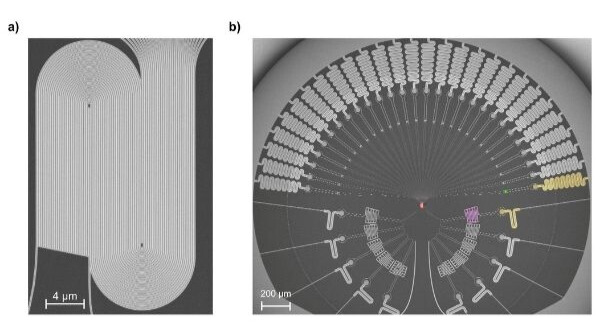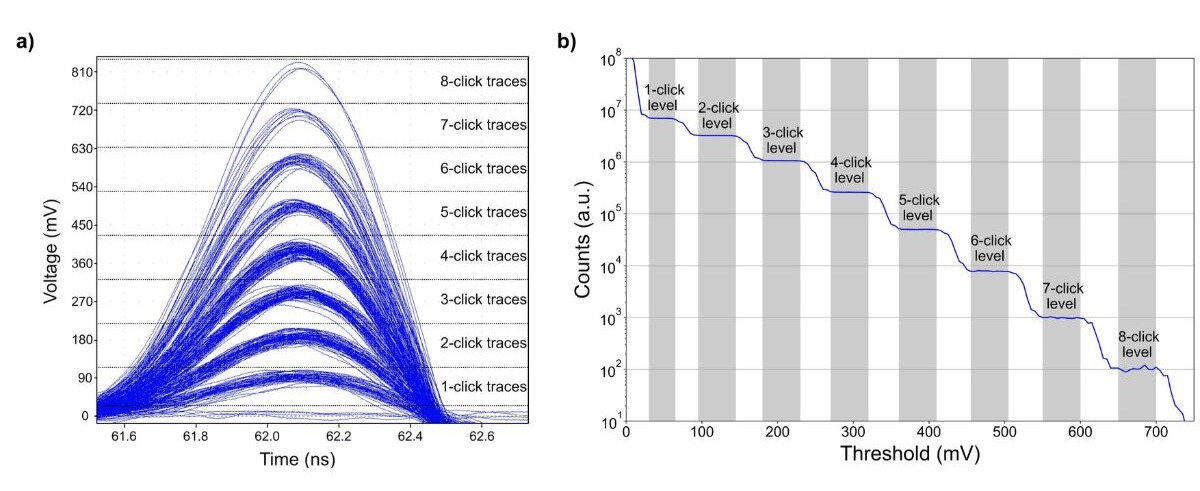The ability to count single photons is central to quantum optics, and a key enabling technology for a range of emerging quantum applications. However, sometimes it is important to know not just that a photon has arrived, but to be able to distinguish between one, two, or more photons arriving simultaneously. This Technology Spotlight will discuss some of the recent advancements in achieving photon-number resolution (PNR) using superconducting nanowire single-photon detectors (SNSPDs), a technology that’s revolutionizing the field of quantum optics.
SNSPDs have emerged as the gold standard for single-photon detection, offering unparalleled efficiency, low noise, and excellent timing resolution. These detectors work by maintaining a superconducting nanowire just below its critical temperature. When a photon strikes the nanowire, it creates a localized hotspot, briefly disrupting the superconductivity and generating a measurable voltage pulse.
See our Technology Spotlight on SNSPDs for more on the basics of these devices.

To address the limitations of traditional SNSPDs, several innovative approaches have been developed to achieve photon-number resolution:
1. Time-multiplexing. This technique uses fiber loops and beam splitters to spread photons across different time bins, allowing a single detector to resolve photon number information. This can be implemented with a traditional SNSPD but has drawbacks such as optical losses due to beamsplitters and fiber loops, and complexity to implement for high photon numbers.
2. Single-pixel SNSPDs with optical beam splitter. By splitting light across multiple detectors, this approach can allow you to infer photon numbers from the number of detectors that click. This has similar drawbacks to the above, including optical losses and challenges with scalability. This approach also requires multiple cryogenic channels and additional readout electronics.
3. Analysis of SNSPD output pulse. Advanced signal processing techniques can extract photon-number information from the shape and amplitude of SNSPD output pulses. This can be implemented with existing single-pixel SNSPDs without additional optical components, but performance degrades rapidly for higher photon numbers (typically limited to 3 at most). This approach is also only compatible with very short optical pulses.
4. SNSPD array with independent readouts. Multiple SNSPD pixels are fabricated on a single chip, each with its own readout channel. This approach allows excellent count rates and timing resolution, and good scalability for increasing photon-number resolution by increasing the number of channels. However, this approach does require one cryogenic readout channel for every pixel, so it is limited by the number of readout channels that can be accommodated in the cryostat.
5. Parallel SNSPD (P-SNSPD) architecture. This innovative design combines signals from multiple SNSPD pixels on-chip, offering a simplified readout while maintaining high performance. This approach offers excellent PNR performance with just a single cryogenic readout channel per N-pixel detector.
For a more detailed discussion of the benefits and drawbacks of these various approaches, see our recent study: High photon-number efficiencies with a fast 28-pixel parallel SNSPD.
P-SNSPDs have shown particularly interesting benefits for many applications, so that is where we will take a closer look next.
Unlike conventional SNSPD arrays that require separate readout channels for each pixel, the P-SNSPD design uses a parallel architecture in which all 28 pixels are connected on-chip, with photon-number information encoded in the amplitude of the output pulse. This allows the entire detector to be read out through a single coaxial cable, dramatically simplifying the experimental setup and improving scalability.
This parallel architecture allows for determination of photon number states without complex post-processing, simply based on discrimination of the amplitude of its output voltage. This can be easily done on a standard time tagger, by creating n copies of the output signal and using different thresholds on different channels to discriminate different photon-number events The use of many pixels allows scaling of n-photon fidelities close to the ideal ‘intrinsic’ scaling dictated by the device’s single-photon efficiency.

Figure 1 a) SEM image of the active 28-pixels arranged in an interleaved geometry. The active area of the detectors is ∼225 μm2. b) Recolored SEM image of the entire parallel architecture. In the center, the 28 active nanowires are recolored in red. In the half-top part, there are meandered series resistors (yellow), ensuring a uniform bias of the pixels, and small series inductors (green), which tune the kinetic inductance of the pixels. In the bottom half, there are the additional unexposed micro-wires (purple) and resistors (yellow) needed to avoid electrical cross-talk due to the current redistribution effect. From Stasi, L., Taher, T., Resta, G.V., Zbinden, H., Thew, R., & Bussières, F. (2024). High photon-number efficiencies with a fast 28-pixel parallel SNSPD. arXiv preprint arXiv:2406.15312.

Figure 2 a) Electrical voltage pulse generated by the P-SNSPD.
Figure 2 b) Plot of counts as a function of threshold, where 8 well-separated regions can be identified. From Stasi, L., Taher, T., Resta, G.V., Zbinden, H., Thew, R., & Bussières, F. (2024). High photon-number efficiencies with a fast 28-pixel parallel SNSPD. arXiv preprint arXiv:2406.15312.
In a recent study, researchers from ID Quantique and the University of Geneva characterized a new 28-pixel P-SNSPD design, that has re-defined the attainable performances of SNSPDs. The reported P-SNSPD shows remarkable photon-number resolving capabilities, achieving 75% efficiency for 2-photon events and 60% efficiency for 3-photon events. The team also successfully reconstructed the statistics of input coherent states at a 40 MHz repetition rate, showcasing the detector’s capabilities for quantum optics experiments.
This performance, combined with high single-photon efficiency (88%), fast detection-rates and low timing jitter, makes P-SNSPDs a powerful tool for quantum applications.
This unique combination makes PNR-capable SNSPDs particularly attractive for quantum information applications, especially those requiring high-speed operations or working at infrared wavelengths. The ability to perform PNR using SNSPDs thus offers a powerful, versatile solution that can be readily integrated into existing quantum optical setups and scaled for future technologies.